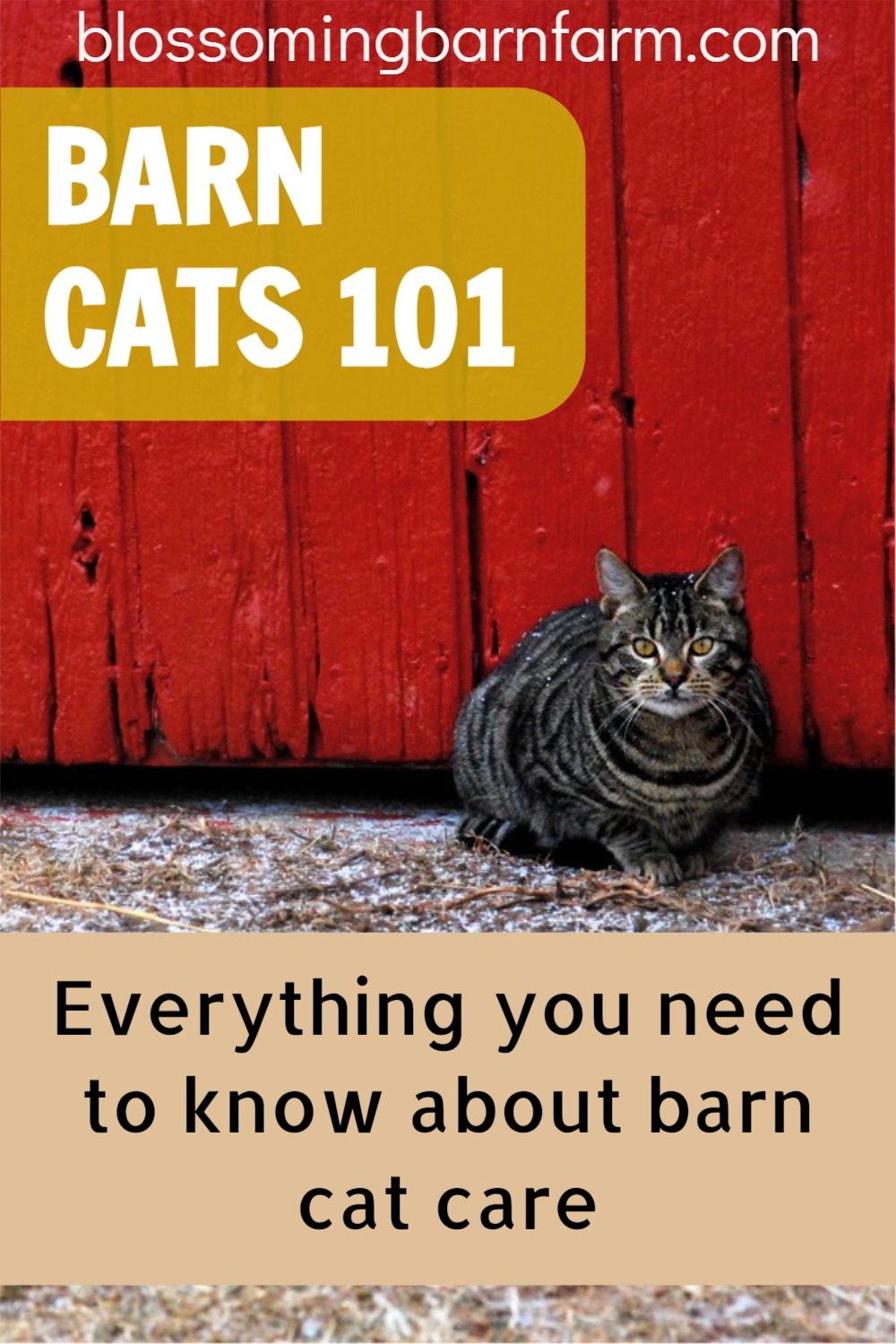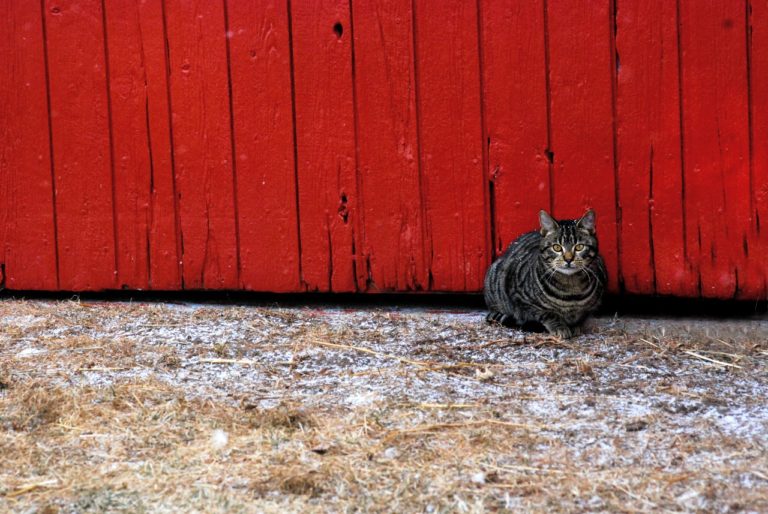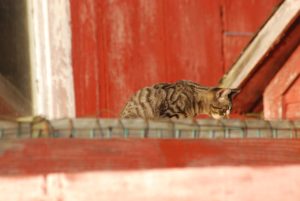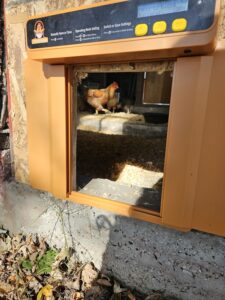This post may contain affiliate links, which means I may receive a commission, at no extra cost to you, if you make a purchase through a link. Please see my full disclosure: https://blossomingbarnfarm.com/disclosure/ for further information.
As an Amazon Associate, I earn from qualifying purchases.
Table of Contents
One of the most iconic animals in farms all around the world is the barn cat.
Barn cats are a wonderful addition to any farm or homestead and come with many benefits
Cats are fun to have around and they’re great rodent control. If you’re interested in bringing a couple of barn cats home, this is the post for you. You’ll learn everything you need to know– benefits, drawbacks, barn cat care, and ethics.
Benefits
Mouse Control
As I’m sure you know, the primary reason that people get barn cats is for rodent control. Cats will hunt anything they can get their paws on, and one barn cat can easily kill between 20 and 300 small animals each year.
This article outlines studies on cats’ hunting habits. They found that domestic cats (presumably pets) caught about 21 small animals per year. Conversely, they found that feral cats killed between 129 and 338 small mammals per year. Since barn cats are neither pets nor always feral, I think it’s safe to say that an average working barn cat will kill a couple of hundred rodents per year.

Don’t worry – even if the cat you happen to pick up isn’t a great mouser, the mere scent and presence of cats on your farm will serve as a deterrent to mice populations. Mice will be less bold when looking for food and less likely to move in.
As any livestock owners knows, mice can wreak havoc on feed supplies and animal health if populations get out of control. Not only will mice eat livestock feed, but they can also carry and transmit at least 35 known diseases. A few common rodent-borne diseases include salmonella, plague, tularemia, and leptospirosis.
Effective rodent management is essential for any homesteader and barn cats can be a great addition.
Entertainment
Another benefit of barn cats is that they’re super fun to have around. I have yet to get bored watching my barn cats George and Milo run around the barnyard playing and climbing.
Barn cats are incredibly entertaining and many of them are friendly too!

Learn about another fun farm animal in my duckling care guide!
Drawbacks
Money & Time
Barn cats are living creatures and will need time and care from you. At the end of the day, proper barn cat care will take a bit of money and time.
I’d say, on average, I spend $10-15 per month feeding two barn cats and $14-16 on flea and tick prevention. In addition, you can expect to pay another $150-$200 or so per year in medical care such as vaccinations, deworming, and fecal exams.
You may also need to spend a little bit of capital arranging shelter for your barn cats. Depending on your existing outbuildings, you might want to invest in a cat bed or house.
Small Livestock Threat

The second drawback of barn cats is that they can sometimes be aggressive to small livestock like poultry and rabbits.
It’s more common for feral barn cats to go after livestock, but any desperate enough feline will attack vulnerable livestock.
Well-fed barn cats usually won’t try to attack your small animals, but it’s never impossible.
Since most cat hunts take place at night, a simple security measure to prevent cats from attacking your animals is to securely lock your small livestock up at night.
Barn Cat Care
Well-Fed Barn Cats Make Better Mousers
I’ve noticed that it’s a bit of a mixed bag when you ask people whether you need to feed barn cats. That said, most people agree that barn cats should at least be fed a portion of their daily nutrition by people.
I’m of the opinion that barn cats should be fed everything that they need for two main reasons: mousing efficacy and ethics.
Contrary to common belief, withholding feed from barn cats will not make them better mousers. While it is true that wild and feral cats hunt to provide food for themselves, a cats’ hunting instinct is not based solely on hunger.
It’s important to understand that well-fed cats will hunt simply for the pleasure of doing so. A cat’s hunting instinct is deeply rooted beyond the need for food. Cats are opportunistic hunters and will hunt whenever the opportunity presents itself – whether they’re hungry or not.
Cat instincts tell them that any small wriggling or flying thing is great to chase. Just like how indoor cats don’t stop playing when they’re well-fed, barn cats don’t stop hunting when they’re fed.
Furthermore, well-fed cats hunt more because their hunts are low stakes. When a cat hunts for survival, it will select its prey based on how easily it can be caught. Cat hunts are estimated to have less than a 50% success rate. Hunting takes energy, and cats don’t want to expend energy on prey they’re unlikely to catch. So, a cat that depends on hunting for food will be more choosey about the prey it goes after and will attempt fewer hunts overall.
Additionally, a healthier cat will be a better mouser. Hunting requires agility, strength, and energy. A malnourished cat will have a higher hunting failure rate than a healthy one.
Finally, feeding your barn cats makes them more likely to stick around your property. While you might not provide food for barn cats, I guarantee that someone in your area will. If your cat finds an easier, more consistent source of food outside your farm, they’re likely to live there instead.
Ethics of Feeding
It’s my belief that if you knowingly bring an animal onto your property, you need to feed it. By bringing a barn cat home, you have taken in out of an environment where it was previously fed or able to find ample food. There’s no guarantee that a cat left on your property will be able to feed itself, so you need to feed it.
What to Feed Barn Cats

I highly recommend buying FROMM brand food. Their food includes the highest quality ingredients and isn’t overly processed. The end product is a moist kibble that cats love to eat!
Get FROMM Cat food Here: https://blossomingbarnfarm.com/FROMM-cat-food
However, feeding wet food daily will help keep the cats coming back. Wet cat food with gravy and meat chunks is much more appealing than kibble. So, feeding a few spoonfuls of wet food each day will entice your barn cats to stick around.
Water
Just like all animals, cats need a constant source of clean water.
If you have existing livestock troughs that are accessible to cats, it’s not necessary to provide a dedicated cat water bowl
Personally, I have a specific water bowl for my barn cats because they don’t have access to my ducks’ water 24/7.
I use this water bowl from Farm Innovators to keep my cats’ water liquid during the Winter. This bowl has done a great job not only keeping the ice away, but also warming the water up to a more palatable temperature.
Get the water bowl: https://amzn.to/3NfLEbC
Housing/Shelter
The next aspect of barn cat care is housing. As I briefly mentioned before, most barn cats will take residence in a garage, barn, shed, coop, etc. But depending on your climate and the degree of shelter that your buildings provide, you might want to provide a separate shelter for your barn cats.
My Favorite Cat House:
With my barn cats, I bought this cat house from K&H Pets. I love this cat house because it is easy to put together and store because it is made of reinforced vinyl. The whole thing connects with velcro, but it’s strong enough for both my cats to lay on the roof.
This cat house did a great job keeping George and Milo warm all Winter long, even down to -15 degrees. The heating pad gets nice and warm but doesn’t waste unnecessary energy by staying on all the time.
And if you like DIY, there are tons of ideas online for easy cat houses. Arguably, the easiest option would be the insulated rubber tote style here.
Medical Care
Just like indoor cats, barn cats need annual vaccinations and monthly flea/tick control. Barn cats also need to be dewormed once or twice per year – talk to your vet about a deworming schedule as it varies by locale and individual worm load.
Because barn cats live outside, they are constantly being exposed to diseases and internal and external parasites. Thus, thorough medical care is very important to barn cat care.
One area you won’t need to worry about is nails. Barn cats need to have sharp claws for hunting, climbing, and escaping predators. Most barn cats wear their nails down naturally by running, climbing, and hunting.
That said, I have seen barn cats’ nails that curled back into the paw pad and caused them to limp. In that case, you would need to trim their nails. Depending on the friendliness of your barn cats, you might be able to do it yourself. If your barn cats are more feral or wary of people, many vets or animal shelters are willing to help.
The Need for Spay/Neuter
Ecological Damage
One aspect of barn cat care that is absolutely non-negotiable is spaying or neutering your barn cats.
Cats reproduce extremely fast, and one female cat can produce up to 18 kittens per year. Out-of-control cat populations can wreak havoc on local wildlife and ecosystems.
The fact is – cats are highly adaptable killing machines. Domestic cat populations thrive in almost every corner of the world and kill over 2.4 million birds each year in the United States alone. This might not sound so bad until you hear that domestic cat populations have caused the extinction of at least 63 species of birds.
Read more on the harmful effects of large cat populations here.
There’s no good reason to let your barn cats breed. In every shelter across the country, there are dozens of feral cats looking for barns and dozens more free kittens bred by irresponsible owners. You don’t need a fancy, well-bred cat to be an effective mouser and any shelter cat would be happy to take up residence in your barn.
Please, do the responsible thing, and spay or neuter your cats.
If you are concerned about the cost of spaying or neutering your cats, most areas offer free or low-cost Trap-Neuter-Release (TNR) programs. These programs allow you to trap feral or barn cats and have them spayed, neutered, vaccinated, and released.
Cat Health
Besides the ecological need to spay and neuter cats, cat health is also improved by these procedures.
Cats that are spayed or neutered enjoy a lower risk of reproductive cancers (such as ovarian, uterine, and testicular cancers), a reduced need to mark their territories, reduced aggression, and reduced wandering. Additionally, spayed/neutered cats are expected to live 3 to 5 years longer, giving you extra years of mouse control!
Barn Cat Training
Really, the only “training” you need to do with barn cats is to teach them where home is.
This involves locking them up in an enclosed area for several weeks so that they come to think of your barn as home.
Barn cat “home training” is less of an issue for young cats or kittens who haven’t had an established territory before. But, if you get adult barn cats, especially feral ones, this lockdown period is essential to preventing the cats from running away. That said, lots of feral cats still struggle to acclimate to a new territory. So, don’t be surprised if your feral barn cat takes off one day.
Another thing that you can do to help prevent your barn cats from running away is to bribe them with tasty food. A nice can of wet cat food once a day will go a long way to keeping your cats coming back.
Ethics of Barn Cats
The last thing I want to talk about is barn cat ethics.
This topic is a debate in the animal welfare community because some people see the practice as cruel.
I believe owning barn cats is ethical if you give them proper care.
Barn cats are just like any working animal on your farm – they need care to provide their service. You wouldn’t buy a milking goat and expect it to feed and care for itself while still providing milk. Likewise, barn cats can’t be expected to do their job if they aren’t cared for.
With their easy care and the abundance of cats available to adopt, barn cats can make a wonderful addition to any farm. I hope you found this article helpful, and happy homesteading!







One Response
Thank you for sharing. I love your emphasis on caring for the cats and spaying and neutering. So important!